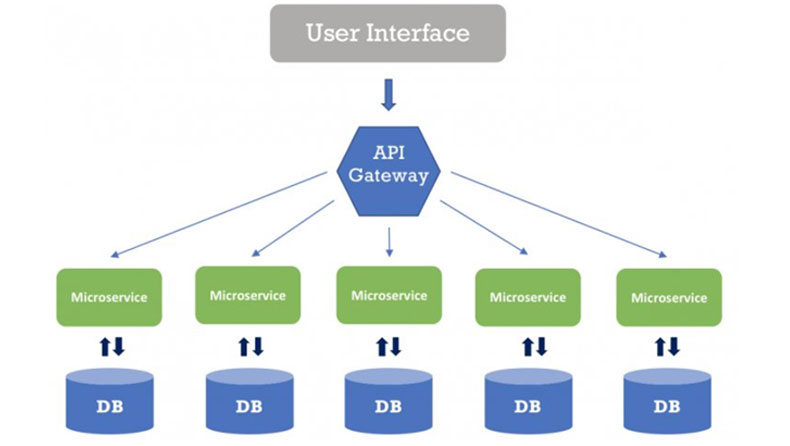Why are microservices rapidly gaining popularity? The list of benefits of the most popular and innovative approach in software architecture. Read the article to find out why microservices are one of the top technologies nowadays.

Table of contents:
- Definition of microservices architecture
- Fast and scalable
- Easier to deploy and improve
- Localization of complexity
- Ease of application of new technological experiment
- Speed of project development
- Flexible outsourcing
- Final thoughts
Definition of microservices architecture
Before diving into the definition of benefits, let’s define what microservices are. Microservice architecture is one of the options for service-oriented architecture. In such an architecture, modules are loosely coupled and interact via API.

Large units are divided into smaller, weakly connected parts. Microservices architecture has become more and more popular in recent years. Due to the greater flexibility, ease of management and debugging, ease of implementation. This is another approach to developing complex applications. This technology was developed to overcome the shortcomings of the classic monolithic approach. In this article, we will look at the main advantages of microservices architecture. Let’s see why it has gained such great popularity.
Fast and scalable
It is believed that performance is much lower due to many loosely coupled modules in the microservice architecture. This is absolutely not the case. Any complex task can be distributed between modules. Whereas in a monolithic architecture, a single block does the job. For example, when working with machine learning, you can process large amounts of data simultaneously. This is achieved by parallelizing and distributing the task to different blocks.
Scalability is also cited by many as a major benefit of microservices. When working with a monolithic architecture, you need to calculate the volume you need in advance. And with microservices, everything is much easier. If the load increases, the data speed increases, then you can deploy several more microservices. Therefore, there is no need to predict the required power in advance.
Easier to deploy and improve
Microservices have less code within their blocks than monolithic applications. Due to the fact that different functions can be broken down into blocks, it is easier to see the line between functions. Each feature can be developed using different technologies and frameworks. This is a more flexible approach than a monolithic one. The monolithic approach uses a narrow technology stack. Each team can use the stack according to their skills. Testing in a microservice architecture is also more efficient. This is because it is much easier to test individual small blocks of code. You can focus on individual functions and give them more attention. As a result, companies get better software.
During updates, you can update one microservice without shutting down the entire system as a whole.
Localization of complexity
One of the microservices architecture advantages is autonomy and independence. Developers can only focus on their specific task, and not on the entire service as a whole. This allows them to develop a better product. By focusing on specific tasks, they do not need to know how other services in the company work. This also affects the ease of finding specialists for the team. The company needs specialists for a narrow area of technology. Complexity localization and the distribution of tasks affect the management of large applications.
Ease of application of new technological experiments
Each of the microservices is independent. That is why you can try different technologies on different microservices. The monolithic architecture uses a lot of dependent code. This is why microservice architecture is easier to implement new technologies and changes. The company can apply new technologies and not dwell on one thing. When a new convenient and promising technology appears, it is not easy to implement in a microservice architecture. Whereas in a monolithic approach it would take a long time. And also there would be a high probability of errors.
Speed of project development
Microservices work independently. Working with one component does not affect others at all. Changing, testing, unrolling one block does not affect the performance of others in any way. When working with small blocks, the development process is accelerated. The team focuses only on a single function and works exclusively with it. This means that it is faster to deliver the application. Delivery speed can be a key factor in operational efficiency. The faster updates are made, new features are added, the more attractive users are.
Flexible outsourcing
Many companies are interested in partially delegating work. However, they often worry about the protection of intellectual property. Outsourcing becomes much easier with microservices. All you need is function segmentation. individual units are outsourced. In this case, the main functions may not be revealed. With a monolithic approach, this is not possible.
Final thoughts
Microservices are really getting more popular every day. This technology is used by the largest companies in the world. There are many microservices case study of this technology.
Famous companies that have already applied it in their work:
-
-
- Uber
- Spotify
- Netflix
-
The features of microservices make companies decide when choosing the type of architecture. There are many adherents of the classic monolithic approach. And they have their own arguments. However, the choice is yours. In this article, you could read about the most basic advantages of microservices architecture. Technology will continue to evolve, and companies using microservices are likely to remain in the perimeter. This is evidenced by both the already successful examples of using the technology and the ease of implementation of updates.











